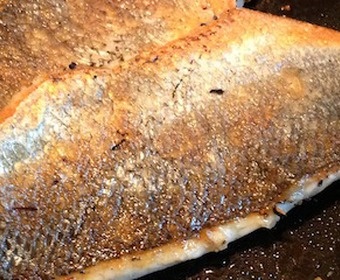
Frying fish like a pro
- Cold fish wants a hot pan, preferably a big one
- Don’t be stingy with the fat
- Finish off in the oven at 175°C
- Coating adds flavor and stops fragile fish from disintegrating
- You want all the pieces the same size when deep frying
Frying fish adds flavor in the form of the frying fat and the browned surface. Fish contains more water and often less fat than meat and therefore it can easily fail to brown at all – or it burns and sticks to the pan. Fish protein also falls apart easily.
The right temperature for fish
Too high a temperature means the fish will burn and stick but if the temperature is too low, it will boil in its own liquid. Get to know your hob and your pans and fry in plenty of fat.
A trick for round fish
A trick when you’re frying a whole round fish: Put a slice of raw potato under the tail and the thin part won’t be over-fried.
“Fry fish on the bone and with the skin left on. It makes for a tastier and juicier result.”
– Chef Linn Söderström, Restaurang Ekstedt, Operakällaren, and more
Flip fish once
Only turn fish once in the pan and finish it off in the oven to increase your chances of it staying in one piece. Use two decent-sized fish slices. Fry at a high temperature to add color and then put the fish in a moderately warm oven, at about 175°C (no more, or the butter will burn) for a couple of minutes until it reaches the desired core temperature.
Not too much in the pan at once
The same goes for fish as for everything else you fry: Too much (cold) fish in the pan means there isn’t enough heat for the water to evaporate. That way the fish will be boiled instead of fried.
Wipe first
The fish should be seasoned with salt and pepper and completely dry on the surface when you put it in the pan. Use kitchen towel or a tea towel.
“Butter, butter, butter.”
– Stefan Eckert reveals a professional secret
Butter or oil for fish
Fry fish in a mixture of oil and butter, it creates more heat resistant frying fat. The oil should go in first. Wait until the butter stops spluttering and baste the fish during frying.
Once you have fried a piece of fish in butter, you’ve virtually created your sauce in the pan. Use normal salted butter. Clarified butter makes it even easier to fry without risking the butter burning but the flavor isn’t quite as good. The brownness in browned butter is what makes it taste so good. Clarified butter can’t be browned.
“Nothing beats the flavor of browned butter. It’s so easy.”
– Chef Per Renhed loves butter almost as much as Chef Stefan Eckert
The right pan for fish
The pan should have a thick base that retains the heat sufficiently to warm up fish cold from the fridge. Stefan Eckert at Lisa Elmqvist recommends cast iron, which is heavy and tough. The pan ought to be able to cope with you basting butter with a spoon, which isn’t the case with Teflon.
One trick when you’re frying is to shake the pan slightly in the first seconds so that the fish browns without sticking. And/or giving it time to gain a caramelized fried surface that loosens from the base. Keeping the skin on fish makes frying easier.
The right oven temperature
Have the oven preheated and ready. When you put fried fish in the oven to finish off, the temperature should be less than 200°C so the butter isn’t burned. Start at 175°C and take it from there.
Fry prawns in oil
Frying large prawns is better in oil. Avoid good quality, cold-pressed olive oil as it can’t cope with high temperatures. Finish off with a knob of butter for more flavor and "roundness".
Scallops
Remove the hard, white bit that is attached to the round part before frying. This is a step people often forget. Clarified butter allows you to fry at a higher temperature and produces a good color. Coating scallops in toasted flour is a trick for getting the perfect color.
Frying several flatfish
If you’re facing the challenge of frying more flatfish at a time than you have large frying pans for, here’s how: Fry them all for 3 minutes on one side and 1 minute on the other. Put them on baking trays in the oven. Finish off at a slightly higher temperature.
Approximate frying times:
• Thin fillets, fry 1 to 2 minutes per side.
• Thick fillets and cutlets, 3 to 5 minutes per side.
Coating fish
Coating fish before frying gives lean fish more flavor because the coating adds a crispy mouth feel and absorbs the flavors of the frying fat.
Coating makes cooking delicate fish even easier. The coating forms a shell that keeps the easily damaged protein together and stops it sticking to the pan.
When frying coated fish, the temperature is particularly important. If you fry at too low a temperature, the fish will release so much liquid that the coating will come away from the fish. If you fry at too high a temperature, the coating will burn before the fish is ready. The pan and the frying fat must therefore be heated up properly when you put the fish in, but can be lowered after that.
A simple coating of flour, à la meuniére, is the easiest method of all.
A spicy coating, for example piccata, is a bread coating with flavors added.
Deep frying fish
If you deep fry often, invest in a deep fat fryer. Deep frying is not considered the ultimate in cuisine, but it is an excellent way to cook delicate, lean fish:
- The temperature of the oil should be 180°C.
- Cut the fish into equal sized pieces.
- Season with salt and pepper before coating.
- Fry in batches so the fish doesn’t clump together and so the temperature of the oil doesn’t drop.
- Also salt after frying.
- Small scampi, prawns and mussels can also be deep fried.
“You can deep fry absolutely anything.”
Peppe Elmqvist, fourth generation fishmonger
Dry frying fish
Fish can be dry fried in a pan with no oil but plenty of salt. It’s an ideal method for fatty fish like herring, salmon or mackerel. it needs a high temperature so cast iron or carbon steel pans are best.
Stir frying/sautéing fish
Quick and light cooking is perfect for fish, but don’t treat it too roughly in the pan as the delicate protein will fall apart. Try with firm types of fish, or fry the fish separately and serve it on top of ingredients that have been stir fried/ sautéed. Many shellfish and squid are delicious stir fried.



